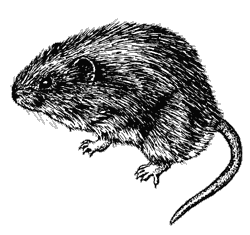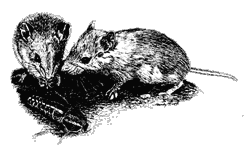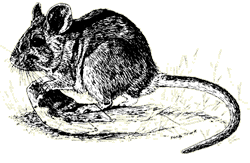Muridae: Mice & Rats
The rats and mice are among the most sucessful mammal groups on Earth. They are adaptable creatures that can inhabit almost any environment. The Sonoran Desert, with its great diversity of habitats, is blessed with an abundance and a wide variety of these fascinating creatures. Here we have predatory grasshopper mice that hunt and kill other mice, and packrat builders that construct houses of sticks and debris up to 2 or 3 feet (1 m) high and 8 feet (2.4 m) wide. The desert woodrat lives in the most xeric (arid or dry) environments, while Merriam’s mouse fills a niche in mesquite bosques.
 |
These little rodents are at the bottom of the vertebrate food chain, preyed upon by everything from coyotes and snakes to hawks and bobcats. In response, they breed prolifically, with some species, like the cotton rats, able to produce 8 to 10 litters a year. Populations still fluctuate with drought and predation, but the mice and rats are able to respond to good conditions by rapidly rebuilding their numbers.
All rodents, including the mice and rats, are gnawers. Their teeth are ever- growing and must be kept trimmed down by constant gnawing. A layer of hard orange enamel covers the front surface of the teeth. The rest of the tooth is softer and wears down quicker than the enamel as the rodent gnaws, thus creating a chisel-like shape to the front teeth that is unique to the rodent family.
—Pinau MerlinSonoran Desert species:
cactus mouse (Peromyscus eremicus)
erriam’s mouse (Peromyscus merriami)
canyon mouse (Peromyscus crinitus)
southern grasshopper mouse (Onychomys torridus)
Arizona cotton rat (Sigmodon arizonae)
white-throated woodrat, or packrat (Neotoma albigula)
desert woodrat (Neotoma lepida)
Order: Rodentia
Family: Muridae
Spanish names: rata (rat), ratón (mouse), rata de campo (woodrat)
Distinguishing features
The three Peromyscus species are similar in appearance, with long tails and big ears. The cactus mouse has a sparsely furred tail with a slight tuft at the tip; its pelage is brownish to cinnamon colored with a white underside. erriam’s mouse is gray with a white underside. The canyon mouse has long silky fur, with the color varying to blend in with the rock substrate on which it lives.
 |
The southern grasshopper mouse is a medium sized gray-brown- to cinnamon-colored mouse with a short, white-tipped tail.
Rats are larger than mice. The Arizona cotton rat is a thick-bodied rodent of medium length, with a thinly-furred tail and small ears and eyes. Its pelage is brown interspersed with black hairs.
The white-throated woodrat (perhaps better known as packrat) is medium-sized (up to 1 pound; .45 kg), with big ears and eyes and a short tail. Hairs on this animal’s throat are white to the bases, while they are gray or dark at the base on the desert woodrat. The desert woodrat is smaller than the white-throated.
Habitat
The cactus mouse lives in the desertscrub and grassland areas throughout the Sonoran Desert. erriam’s mouse is only found in the low desert mesquite bosques in south-central Arizona. The canyon mouse inhabits the canyons, rocky slopes and cliffs of northern and western Arizona. The southern grasshopper mouse lives in grassland and desertscrub communities in southern and western Arizona. Cotton rats are usually seen in grassy areas near streams and ponds and around irrigated fields.The white-throated woodrat is found throughout most of Arizona and Sonora in a variety of habitats, especially in areas with mixed cacti. It can live in very arid environments as long as prickly pear or cholla are available. The desert woodrat lives on desert floors or rocky slopes; its range includes most of the western Sonoran Desert, extending south into Baja California.
Feeding
• Diet: The cactus mouse, canyon mouse and Merriam’s mouse all eat seeds, mesquite beans and leaves, and to a lesser extent, green vegetation, and insects. Grasshopper mice are predators, hunting insects, beetles, grasshoppers, and scorpions, but they also hunt and kill other mice. Cotton rats eat mostly green plants and grasses. woodrats eat mesquite beans, palo verde seeds, green plants, and cacti, particularly prickly pears and chollas, which provide them with moisture as well as food. Occasionally they eat insects or other meat.
• Behavior: The Peromyscus are all skilled climbers of the cacti, trees, and cliffs in their various habitats, using their long tails for balance and support as they move about at night in search of seeds and invertebrate prey. During the day they remain in burrows in clumps of cacti, in the ground, or among rocks. Cotton rats construct little tunnels or runways in grasses and weeds where they can forage in safety.
The grasshopper mouse is an efficient predator, killing other mice with a bite to the back of the neck, and biting the stingers off scorpions before consuming them. Pinacate beetles emit a toxic spray from their rear ends, deterring most predators, but grasshopper mice catch them and shove the defensive ends of the beetles into the sand, then bite off the good parts, leaving beetle bottoms embedded in the sand.
Woodrats forage at night, eating food and carrying some items back to the house to store for later use (as is the case with mesquite beans), or to incorporate them (especially cactus parts) right into the house structure.
Life History
 |
The cactus mouse often climbs around in vegetation and brush, searching for seeds and fruits to eat. It may nest in wood piles or rock piles, or use the abandoned burrows of other animals. Although this mouse needs less water than many others, and is desert-adapted, it may estivate or go into a torpor in the summer when resources for food and moisture are not available.
Merriam’s mouse also climbs the mesquite trees and shrubs of its habitat in search of food. The canyon mouse doesn’t burrow, instead placing its grassy nest in a natural cavity or rocky crevice. The fur color of this mouse usually matches the color of the cliffs and rock walls it haunts.
Grasshopper mice not only hunt prey, they also have lifestyles reminiscent of canid hunters. They form family packs with both parents feeding and caring for the young and teaching them how to hunt. They defend a territory, but will range widely in search of food.
The grasshopper mouse even vocalizes like a tiny wolf, standing on its hind legs, throwing back its head and howling. These eerie, high pitched calls may be used to communicate with other family members.
Cotton rats are active day or night and are often found in dense populations. A high density of these rats usually attracts predators, which then reduce their numbers.
Woodrats are famous for their houses made of sticks, cactus parts, animal dung and debris, usually tucked in around a prickly pear cactus, under a mesquite tree or hackberry bush, or among boulders. The house acts as insulation for the nest, which is underneath but close to the ground surface. The spiny cactus parts may also offer some protection from coyotes digging up the nest. Several entrance holes allow the packrat a quick escape should a snake come visiting. Packrats are solitary, with only one rodent per household, unless a female has young.










